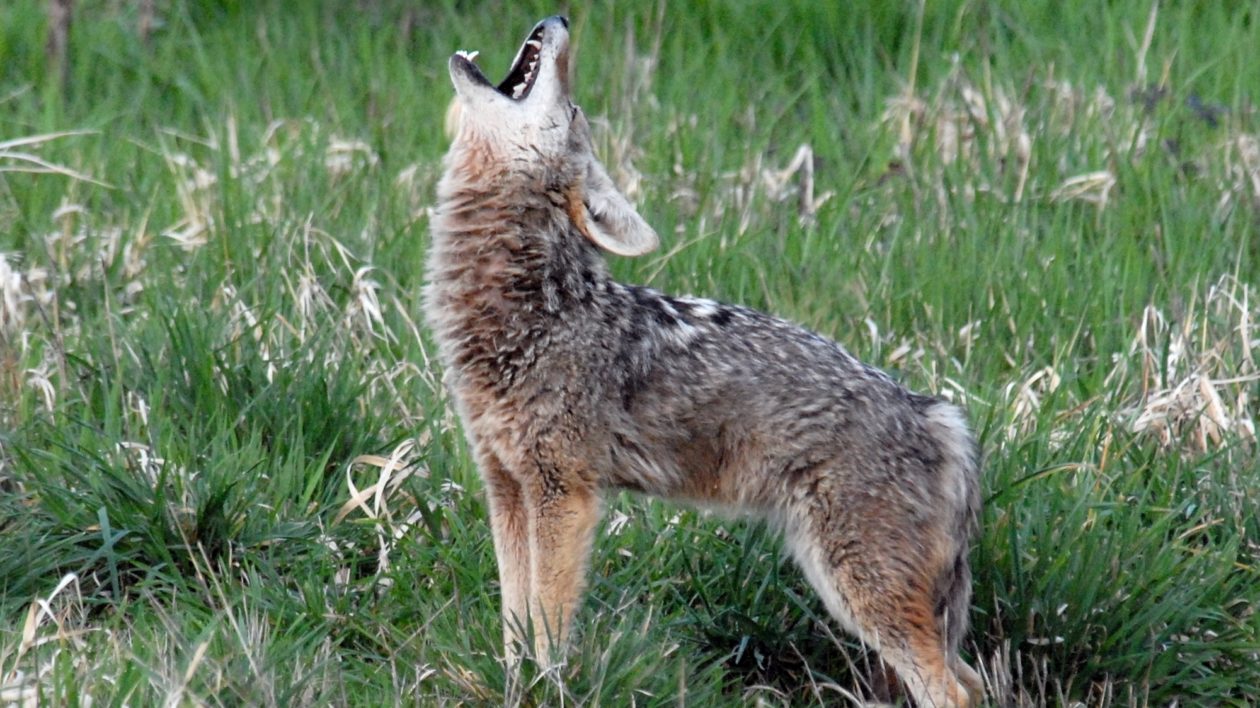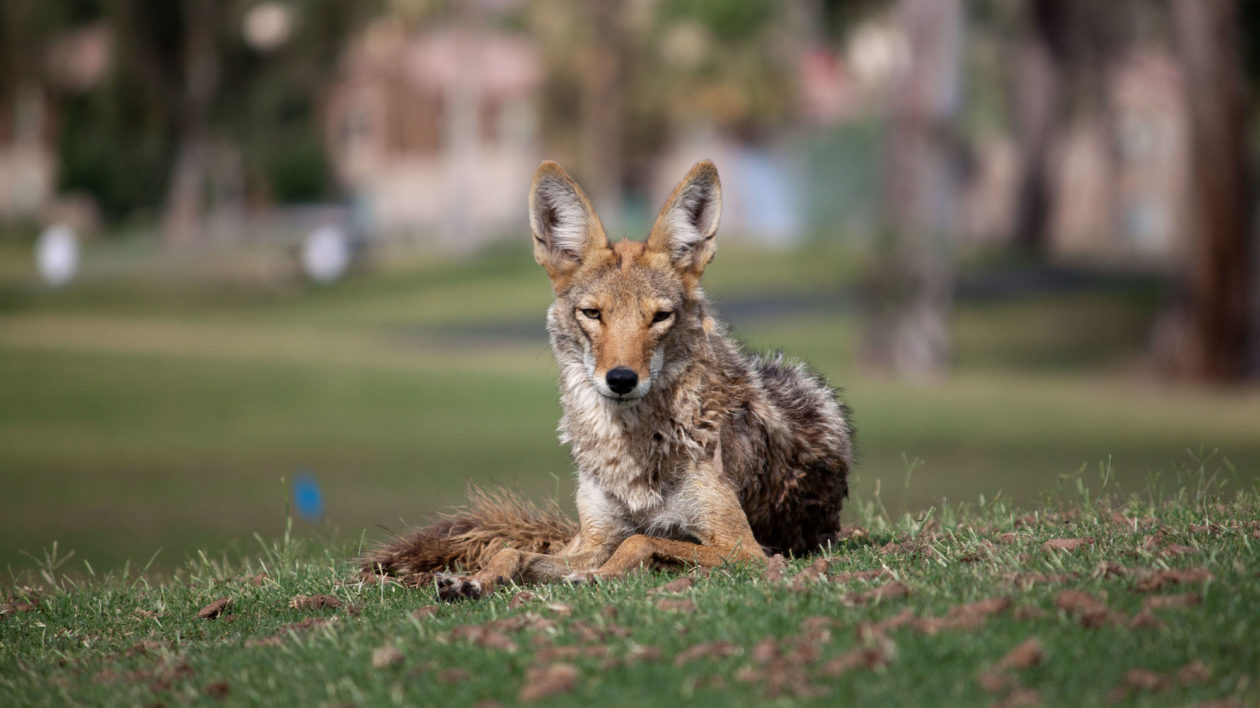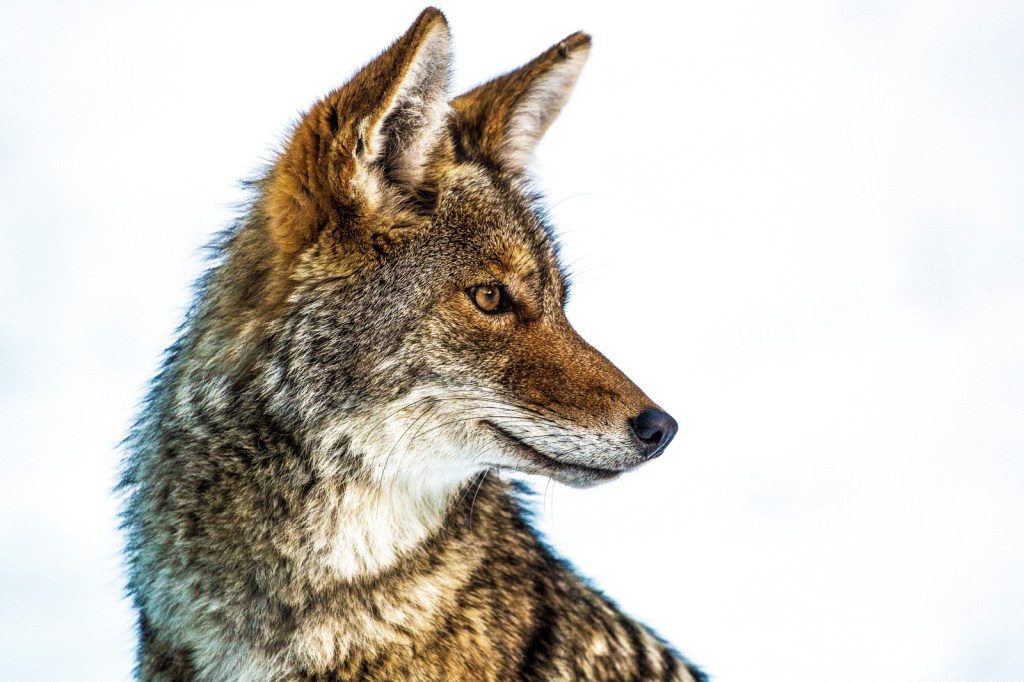I stepped outside last night to take some glass bottles to the recycling bin. The evening was clear, cold and seemingly silent. I hurried with my task, no wanting to linger in the chill. And then a howl rippled through the air. Coyote. The sound echoed through the neighborhood, carrying clearly from a nearby hillside.
I stopped and enjoyed the vocalizations. The long howls were interspersed with sharp yips, sounding like multiple animals. It lasted for several minutes.
I never tire of that sound, no matter how many times I hear it. And this time of year, I enjoy the coyote concert frequently.
Coyotes are one of the most vocal mammals. And they’re also now found widely, so if you live in North America, there’s a good chance that you have some roaming near you.
You can hear them at any time of year, but you may notice increased activity in February and March. And, if you’re like me, you’ll find the howling particularly resonant on a cold winter’s night. Here’s what’s going on.

The Pair Bond
Quite simply, it’s breeding season. While the exact timing varies, depending on geography, coyote breeding season generally occurs between late January and March. Coyotes are generally monogamous, forming strong pair bonds for several years. Some researchers state that the coyotes will remain together until one of the pair dies.
Coyotes are also territorial. The pair howls and yips to let other coyotes know that they have an established territory and not to intrude.
Coyote researcher Brian Mitchell describes the sounds you’re likely to hear at this time of year:
“Group yip-howls are produced by a mated and territorial pair of “alpha” coyotes, with the male howling while the female intersperses her yips, barks, and short howls. “Beta” coyotes (the children of the alpha pair from previous years) and current year pups may join in if they are nearby, or respond with howls of their own.”
Mitchell also notes that other nearby pairs may then respond, announcing their own territories. At such times, it can sound like a cascade of howls across the landscape.
According to Mitchell, this is not the only time of year that coyotes establish their territorial boundaries. The pups are born later in spring, and will form a loose family group. A pack of coyotes howling is an iconic sound of the American West, and it likely serves dual functions. Mitchell writes:
“The group yip howl is thought to have the dual purpose of promoting bonding within the family group while also serving as a territorial display. In other words, the coyotes are saying “we’re a happy family, and we own this turf so you better keep out.” In a sense, the group howls create an auditory fence around a territory, supplementing the physical scent marks left by the group.”

Song Dog
Howling may be the most recognizable coyote vocalization, but these canids actually have a wide repertoire of sounds. (One of the animal’s more endearing nicknames is “song dog”). Researchers generally identify 11 vocalizations that serve a variety of functions, from alarm to warning to socialization.
There is much we don’t understand about the coyote’s calls. Their “language” is likely far more complex than we can comprehend. Researchers like Mitchell note that coyotes have accents that vary geographically and even among family groups, much like humans. And coyotes can recognize another coyote by its distinctive call.
Even though coyotes are one of the most common and adaptable predators in the world, there is much we don’t understand. And there’s also a lot of contradictory information – and complete nonsense – written about coyotes.
There are two reasons for this. Coyotes are relentlessly persecuted throughout their range. A lot of people kill or attempt to kill coyotes, and oftentimes they present their own opinions as fact.
For instance, people often grossly overestimate the number of coyotes in an area. When a couple of coyotes begin calling, their sounds can vary rapidly in pitch and sequence, which can sound like a lot more coyotes than actually are there. Coyote howls often echo against hillsides, compounding the confusion.
This actually may provide a benefit to coyotes. As they establish their territory, sounding like a big pack may deter other coyotes from entering the territory.
I have often heard local hunters describe areas “absolutely overrun with coyotes,” based solely on the howling they’ve heard. Most likely, they were fooled by just a few animals.

A Flexible Lifestyle
I suspect there is another reason for a lot of the contradictory information about coyotes and their behavior. It’s because coyotes behave differently depending on habitat, interactions with humans and other factors.
Coyotes are one of the most adaptable predators. They are found in the Idaho wilderness near my home, but also can live in the midst of large cities like Chicago and Los Angeles. They live in farm country, in suburbs and in urban parks.
The reason that they can thrive in so many different habitats is that they are very flexible and adaptable. They will change their diet and their habits to fit the environment.
So a coyote’s territory and pack bonds are likely different on the public lands of the Rocky Mountains than they are in a suburban neighborhood.
One of the differences some researchers have recognized is that urban coyotes likely vocalize less. I live in an area surrounded by a large wildlife management area and a river greenbelt. I hear coyotes regularly. If you live in a city, you may not hear coyotes as much – but that doesn’t mean they’re not there. They have just found it easier to survive by being quiet.
If you do happen to find yourself in some wide-open spaces this month, step outside in the night and have a listen. You may enjoy one of the great sound shows in nature, the chorus of yips and howls. The coyote survives and thrives despite us, and its howling serves as a reminder to the wildness still in the world.




I have lived in Arizona, Washington State and Idaho, and I immediately learned that coyotes in one state sound very different than coyotes in another state. They do indeed seem to have accents.
Good morning from the Columbia River gorge, where the coyotes are yip-yipping even in broad daylight! A particularly unusually yippy concert very early this morning made me google “why do coyotes yip?”, which brought me to your article; a very enjoyable read, thank you! “Song dog”: that’s a keeper!
Thanks for a beautiful and informative write-up. Appreciated.
I couldnt have said it better
Well done
I noticed it some time back and have decided to mention it. The pictures that Matthew Miller has in his article are the EXACT same pictures that the people in charge if reintroducing the red wolf in North Carolina sent me.. They call them RED WOLVES.
.
I really enjoyed this article. I live in the Northeast and I find myself constantly attempting to educate my community about these beautiful animals. There is so much unfounded fear around coyotes, I feel that they are so often mischaracterized and misrepresented in the local media and by community members. They continue to push a narrative of danger and fear, saying that they are going to attack their children even though there is no evidence to suggest that this is a valid fear. I try my best to provide folks with educational resources and some people are receptive but, sadly, most people what them killed just for existing and being in their neighborhoods, even when the do exactly as they should when they see people and scurry off. I really appreciate their beauty and their wildness and I, too, have always been moved by their beautiful howls. It evokes an ancient feeling and sense of natural spirit. I was happy to come across your article to know there are others out there who appreciate these beautiful wild animals when I am, otherwise, constantly faced with and struggling against the unreasonable and unfounded rhetoric about them. Thank you.
We heard coyotes last night. I love hearing them and they do remind me of “the wildness still in the world”, for which I’m so grateful. Thank you for caring about them and sharing your knowledge!
My silky terrier was just killed by a coyote. I need to know if he suffered. This happened just hours before we would be home. Please give me some peace about this.
I live in a small town in the upper part of the state of South Carolina. I was aware that coyotes live around us as I had seem some a few times on walks. but last night, it must have been a family hanging out together as they started up a yipping ruckus that went on for several minutes! My two dogs that were inside the house were barking and carrying on themselves as well. I wondered if they were joining in the symphony! 🙂
Good afternoon, there is a den of coyotes ina wooded area not far from my home (an hour north of NYC) and since the covid outbreak I’ve been walking on my cup de sac most evenings which abuts the woods – is there any chance they would menace me, thinking I’m to close to their territory? I don’t leave the paved road and the woods are a small distance from the road – thank you for your response
Thanks for your question. There is almost no danger to humans from coyotes. Do not feed them or acclimate them to humans. They almost always avoid humans and are more afraid of you than you are of them. Domestic dogs are much more dangerous than coyotes.
Enjoy the chance to view these elusive predators. Respect them but there’s no reason to be afraid. I have been hiking in areas with a significant coyote population for years and have never once had one approach me.
Best,
Matt Miller, Cool Green Science editor
Very good article- and completely factual. As a hunter and trapper in the Southeast- central MS is home, but I frequent parts of AR and have family in NV and OR- and it has been pretty interesting to listen to all the very different “philosophies” out there about coyotes. Whether you are a farmer/rancher or just an urban dweller that rarely frequents the great outdoors, chances are good that you’ve had a song-dog encounter…and formed your own opinion about them. As for me, I have a fascination and a big respect for their adaptability and ‘stubborn’ cunningness to just consistently survive- and thrive.
I help manage a 2600 acre property that is within 6 miles of a decent-sized town. (its one of the last big stretches of “undeveloped” forestland, and I’m sure will eventually be a major subdivision (homes); The mostly pine timber on the property has had several stretches of select timber-cuttings- opening up many 10-40 acre ‘openings’ on it- making it ideal habitat for turkeys, deer, rabbits; and of course -predators. Fellow hunters often talk about hearing “packs” of coyotes in the pre-dawn or dusk periods- when , in fact, as you point out- the actual SIGN (I liken this to forensic -evidence of the outdoors), tells that we probably only have 1-3 actual ‘family groups’ . Two to three seasons of trapping (something I’ve done since I was 15- in the 1970’s), mixed in with a bit of predator-calling have pretty much proven this theory- way more bobcats & fox have been taken than coyotes on the place. Regardless, it’s very enjoyable to do, it helps the landowners and the hunting-club and definitely the wildlife population. I’ve traveled through a bit of Idaho- it’s a beautiful state- you are fortunate to have all it offers at your fingertips. Thank you for all you do and again, a great article. Sincerely,
Dan Davis
Brandon, MS
I was born in 1934 in the pineywoods of east Texas. I listened to the Red Wolf howl as far back as i can remember until i was about 11 years old (1945). They would blow a steam whistle at a sawmill at 6 o’clock to wake up mill workers. The wolves would always answer. Sometimes three packs would be close enough to hear. There was no underbrush under the virgin pines. When the trees were cut, underbrush took over. The wolves couldn’t catch prey in the thick brush so they died out. They were open forest wolves.
I spent 35 years in Alaska listing to the Gray Wolf howl. If you ever get to listen to a Red or Gray wolf howl, i don’t think you would care much for the yapping coyotes any more. (I am not talking about the so called Red Wolves in North Carolina. They have been crossing with coyotes for 30+ years. They look & sound like coyotes.
Excellent!
Just last night my wife and I enjoyed the fleeting but utterly mesmerizing coyote chorus, courtesy of the coyote family that lives near the University of Minnesota St Paul campus and the State Fair property. From time to time, and always at night, we have had this experience. We have also seen a few, heading north, through the U of Mn agricultural fields and across our apartment parking lot to other fields beyond Larpenteur Avenue. Before moving to the apartment we had occasionally seen a lone coyote in the neighborhood but now we hear more than see and are rewarded every week or so. At times it seems the sounds come from one direction and at other times they seem to come from many directions simultaneously. Once I thought a police siren may have prompted the event because the pitch of it and the coyotes sounded to me like both were attuned.